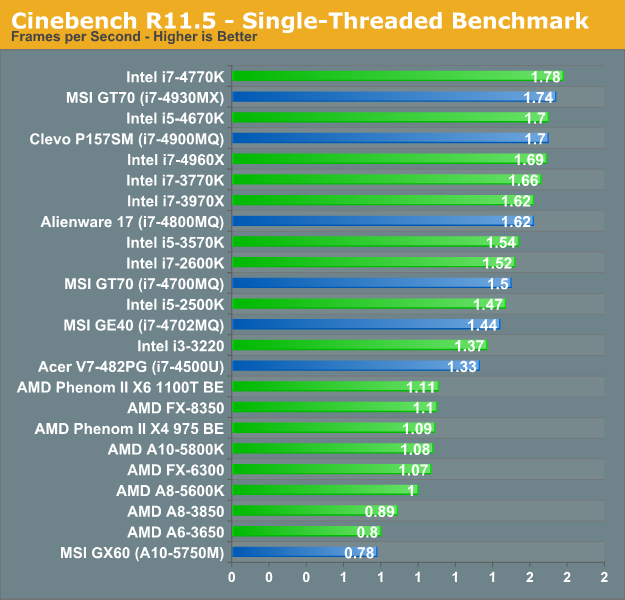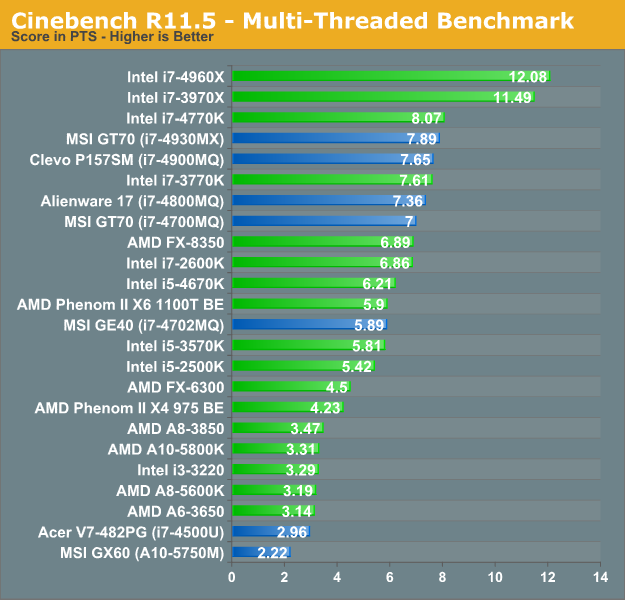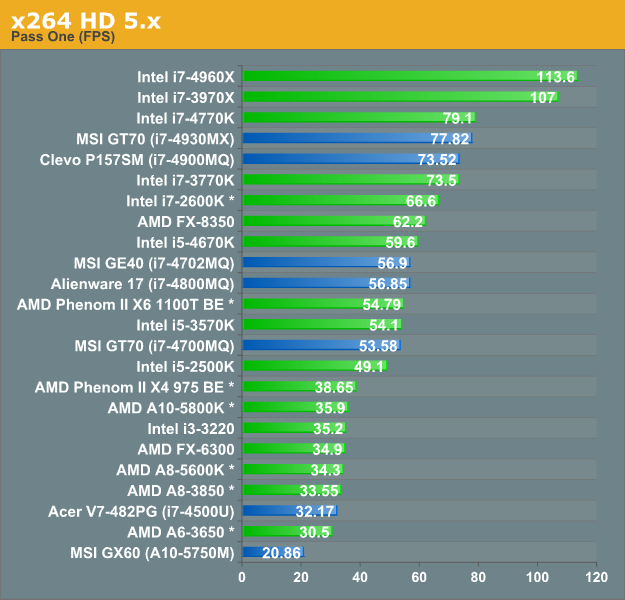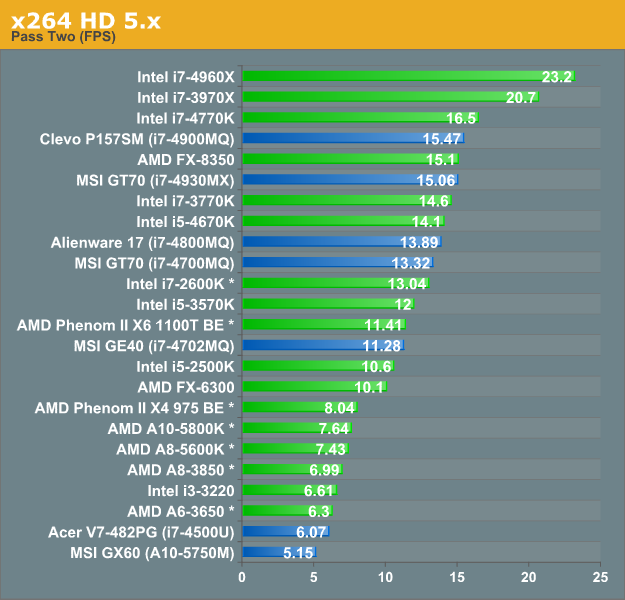Analyzing the Price of Mobility: Desktops vs. Laptops
by Jarred Walton on September 7, 2013 5:55 PM ESTCPU/General Performance Discussion
With that out of the way, let’s focus on the remaining two areas, starting with CPU performance. I’ve grabbed several generations of desktop CPUs from both AMD (K10.5, Llano, Trinity, Bulldozer, and Piledriver – we don’t currently have Richland results, but they’re generally 5-10% higher than Trinity) and Intel (Sandy Bridge, Sandy Bride-E, Ivy Bridge, Ivy Bridge-E, and Haswell) and combined those results with the latest mobile CPUs (Haswell quad-core, Haswell ULT, and Richland). We’ve got two benchmarks that are common to our CPU and laptop we’re going to look at: Cinebench 11.5 (single- and multi-threaded) and x264 HD 5.x video encoding (first and second pass).
Unfortunately, we don’t have results for all of the desktop CPUs in x264 HD 5.x, though you can get an idea of where they should fall by looking at the x264 HD 3.x results. We’ve gone ahead and used the x264 3.x scaling for desktop CPUs where we don’t have 5.x results, and marked those results with an asterisk (*) in the following graphs. The first pass tends to be about 2x as fast with x264 HD 3.x, unless you have four cores with Hyper-Threading in which case scaling is closer to 1.5x (and 6-cores results in scaling of around 1.08x). The scaling in the second pass is much more uniform, with 3.x being around 2.75x as fast as 5.x. Since we’re already comparing apples and oranges in a sense (desktop and laptops, with different motherboard, RAM, etc.) we’re really just interested in an estimate of performance. Do not take the following charts as 100% definitive, but rather as a baseline comparison.




It used to be that if you wanted top CPU performance, a desktop system was absolutely required. These days, for lightly-threaded workloads the gap has narrowed substantially: a moderate i7-4700MQ Intel Haswell processor will get you around 85% of the performance of the desktop i7-4770K, and the i7-4930MX will get you 98% of the single-threaded performance. Even the i7-4500U Ultrabook is able to deliver 75% of the 4770K performance. Move to heavily threaded workloads and the gap grows (particularly if we included the hex-core processors), but the 4700MQ and 4930MX are still 81-87%/91-98% of the 4770K performance – it’s the dual-core mobile CPUs that really take a hit, with the i7-4500U delivering roughly one third (37-41%) the performance of the 4770K. Of course, if you’re not doing CPU intensive tasks like video encoding, the single-threaded performance will be the more pertinent result.
The AMD side of the equation isn’t nearly so rosy, at least if you want performance anywhere near that of a top-end desktop. Llano, Trinity, and Richland have been far more focused on reducing power use and increasing integrated graphics performance than on boosting CPU performance. The result is that in single-threaded performance, the fastest mobile Richland APU is less than half the performance of the 4770K, and in the multi-threaded tests it’s 26-31% of the 4770K performance. Comparing mobile Richland to desktop AMD parts doesn’t really help much either: in the single-threaded Cinebench result, it basically matches the Llano A6-3650 and is 12% slower than the A8-3850, while it trails most of the other AMD CPUs/APUs by nearly 30%. Move to multi-threaded workloads and it’s only able to deliver 30-60% of the more powerful AMD desktop APUs (and 60-80% of the desktop Llano APUs). Richland is still “fast enough”, but it’s definitely a value proposition as opposed to a performance option – the iGPU of Richland may be faster than HD 4000/4400/4600, but dGPUs like the GT 730M are still roughly twice as fast and available for not much more money. But we’re skipping ahead….
Summarizing the general performance of our mobile platforms, we’re able to come pretty close to the performance of desktop systems, and while there’s still a price premium in effect it’s definitely getting smaller than in the past. The least expensive laptop/notebook I can find right now with a quad-core Haswell CPU is the HP Envy 15t-j000, which you can currently get for $700 after the $100 instant discount. That will get you 8GB RAM, 1TB HDD, and Windows 8, but not too much else. Adding a 1080p LCD ($50), GT 740M ($70), and a backlit keyboard ($30) brings the total to $850. That’s roughly the same performance as a Sandy Bridge i7-2600K, and slightly faster than the Haswell i5-4670K. You can get a pre-built desktop from Newegg for $700 (which adds in an HD 7750 GPU), while a DIY system with similar specs to the laptop (e.g. no dGPU) will set you back $672 (see table below) – not including a mouse, keyboard, display, or speakers.
| Mainstream Desktop PC | ||
| Component | Description | Price |
| CPU | Intel Core i5-4670 (Quad-core, 3.4-3.8GHz, 6MB L3, 22nm, 84W) | $200 |
| Motherboard | ASRock Z87 Pro3 LGA-1150 | $115 |
| Memory | 2x4GB DDR3-1600 CL9 1.5V RAM | $65 |
| Storage | Seagate 1TB 7200RPM HDD | $70 |
| Optical Drive | SATA DVDRW (Lite-On) | $18 |
| Case | Antec Three Hundred | $60 |
| Power Supply | Seasonic 350W 80 Plus Bronze | $44 |
| Operating System | Windows 8 64-bit (OEM) | $100 |
| Total | $672 | |
In other words, if all you want is a computer for moderate needs, it’s not hard to see why laptops are displacing desktops for many people. In this case we’re able to get the same level of performance for potentially less money (depending on whether or not you need to buy an LCD, keyboard, and mouse). Desktops are still going to be far more upgradeable, and you can take a “basic use” desktop like the one above and upgrade it with a high-end graphics card for $300 to get a potent gaming PC. Adding more memory, more storage, upgrading the motherboard and CPU, etc. are all things that you can do with a desktop, whereas with laptops typically only the RAM and storage can be upgraded/replaced and if anything else breaks you’ll have to send it in for repairs (or buy a new laptop).p
We can go down to lower price points of course – there are desktop PCs with moderate hardware starting at just over $300, and they’re still more upgradable than laptops, but similar performance laptops can be had for about the same price, especially if you look at some of the previous generation hardware. It’s mostly a question of how much performance you want/need, and whether you’re interested in the potential to upgrade components down the road. If you don’t have any plans of adding more RAM, storage, or a GPU the case for laptops is stronger now than ever. And let’s not forget that most laptops have an idle power draw south of 20W, compared to 40-60W for a typical desktop (and that’s not including the display or speakers on the desktop), so the energy factor also favors laptops.










110 Comments
View All Comments
nerd1 - Monday, September 9, 2013 - link
You can put two chargers in parallel to double the power, which is needed for some exotic laptops.JarredWalton - Monday, September 9, 2013 - link
None of the Clevos or Alienwares do this, at least not that I've seen. What "exotic laptops" are you referring to?nerd1 - Monday, September 9, 2013 - link
Some Clevo ones with desktop processors.JarredWalton - Monday, September 9, 2013 - link
Ah, I see now that they changed to dual 330W adapters with the P570WM. I didn't realize that, but then I can't say it matters much to me. It's an extremely niche market, and the P375SM is more sensible for almost everyone other than perhaps mobile workstation users that need a 130W hex-core processor. I suppose I shouldn't be surprised at the dual adapters -- the old Clevo X7200 and P270WM could actually overload the old power brick under load. So, who wants to carry around 22 pounds of notebook?Dribble - Monday, September 9, 2013 - link
I own a fast laptop and a fast desktop and have done for years now. The one thing that can't be understated is how much easier it is to fix and upgrade the desktop. Upgrades to laptops basically means SSD's and memory. With a desktop you can upgrade pretty well anything - add graphics, no problem, and more hd's no problem, etc.Equally fixing laptops is hard work. Some stuff can't be fixed and other stuff is tricky. e.g. I successfully replaced the screen inverter in my last one, but that involved taking the whole thing apart (seemed like about 100 screws) then replacing the inverter then putting it all back together. With a desktop that sort of thing would be a 5 minute job.
Hence I still love my desktop - it o/c's well, is faster, quieter, cheaper, easier to maintain and easier to upgrade.
Jaybus - Monday, September 9, 2013 - link
For many tasks I do not care if I am using a laptop or desktop, as long as I have a real keyboard and mouse and a couple of large monitors. However, I need PCIe slots for ADCs and hardware other than a graphics card, making laptops impossible or at least difficult and expensive to use as my main workstation. If Thunderbird or something similar is someday able to handle the hardware, then I truly won't care.However, I still want a fixed location workstation in addition to a light laptop. Laptops are too vulnerable to theft and/or destruction while travelling, so I don't want all of my files on the laptop. Just the ones I will need while travelling.
Spunjji - Monday, September 9, 2013 - link
Thanks for this, Jarred. It's really great to see such a comprehensive analysis put together off the back of a user comment - it really does put these price/performance trade-offs in perspective in a way that's useful fr us, the end users. Bravo!Incidentally, I also feel happier about my own setup after reading this - £800 for a second-hand 2670QM Clevo unit with 16GB RAM and a 7970M was some pretty excellent value. :D
DrJeckyll - Monday, September 9, 2013 - link
Good review in general. I think that making a better comparison would be to include peripherals though, to make it a more apples to apples comparison.I, for one, just bought a true desktop replacement (Eurocom P375SM with an 8970M). For me, being able to game while on the couch is a big bonus and the capability to pick up and go in a heartbeat is nice. In terms of upgrade-ability, it's a clevo so I can change any component easily; and I ended up paying quite a bit less than a regular laptop in this class bringing the gap between desktop gaming even lower.
Another interesting comparison would be to build a mini-ITX system.
JarredWalton - Monday, September 9, 2013 - link
The problem with peripherals is that there's a huge range of quality. If we're building "comparable" to the notebooks, we'd want a basic 1080p TN display, cheap stereo speakers with a subwoofer, any pretty much keyboard and mouse. But realistically, most desktop users will have at least a decent quality 21.5" or 23" display, and many will now opt for a 27" 2560x1440 IPS display for $400-$500. I use 5.1 speakers still, an old set of Logitech speakers I've had for about 10 years now, maybe more? (How's that for longevity?) And for the keyboard and mouse, I'm currently rocking a $250 keyboard with a $65 mouse, but quality on these items is far more important to me than saving pennies.SirNathan - Monday, September 9, 2013 - link
You mention on the first page that a tablet with a keyboard is around $500, but if you get the Nexus 7, you can get a pretty good third party keyboard for around $30. Of course, then you'd have to do without Windows, so it doesn't work so well for comparisons in this article...